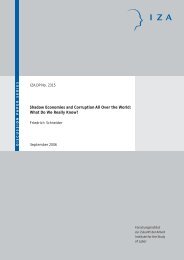Minimum Wages in Kenya Mabel Andalón - Index of - IZA
Minimum Wages in Kenya Mabel Andalón - Index of - IZA
Minimum Wages in Kenya Mabel Andalón - Index of - IZA
You also want an ePaper? Increase the reach of your titles
YUMPU automatically turns print PDFs into web optimized ePapers that Google loves.
general order regime, non-compliance was higher <strong>in</strong> municipalities other than Nairobi<br />
and Mombassa (Table 8).<br />
The ILFS data allows identify<strong>in</strong>g the percentage <strong>of</strong> workers whose earn<strong>in</strong>gs are at the<br />
m<strong>in</strong>imum wage level. This percentage is usually identified with the term ―Fraction‖.<br />
Only a small fraction <strong>of</strong> salaried workers received monthly wages equal to the statutory<br />
m<strong>in</strong>imum. If fraction is measured as all workers whose earn<strong>in</strong>gs are with<strong>in</strong> a range <strong>of</strong><br />
plus/m<strong>in</strong>us two percent <strong>of</strong> the statutory m<strong>in</strong>imum wage, it is found that only 0.3 percent<br />
<strong>of</strong> the workers <strong>in</strong> agricultural activities, and 2.1 percent <strong>of</strong> workers <strong>in</strong> urban areas had<br />
earn<strong>in</strong>gs with<strong>in</strong> that range (see Table 4, column identified as fraction at +/-2 %) Even<br />
when this <strong>in</strong>terval is <strong>in</strong>creased to plus/m<strong>in</strong>us 5 percent <strong>of</strong> the m<strong>in</strong>imum wage, the share <strong>of</strong><br />
workers whose earn<strong>in</strong>gs fall <strong>in</strong> that range is not very large: 6.8 percent for agricultural<br />
and 2.9 for urban workers. The fraction at the m<strong>in</strong>imum wage is higher for men, less<br />
educated and young workers.<br />
The number <strong>of</strong> workers whose wage and employment status are potentially <strong>in</strong>fluenced by<br />
the m<strong>in</strong>imum wage <strong>in</strong>creases somewhat if we adopt as a measure <strong>of</strong> the importance <strong>of</strong> the<br />
m<strong>in</strong>imum wage the fraction affected, that is the proportion <strong>of</strong> workers whose wages are<br />
just above the 1998 m<strong>in</strong>imum wage, but below the wage set the follow<strong>in</strong>g year <strong>in</strong> May<br />
1 st , 1999. 7 These workers could have potentially lost their jobs after the follow<strong>in</strong>g update<br />
if the wage <strong>in</strong> 1998/99 reflected their productivity. Accord<strong>in</strong>g to this measure, 8.1 percent<br />
<strong>of</strong> the workers <strong>in</strong> agriculture and 5.1 <strong>in</strong> general order were at risk <strong>of</strong> be<strong>in</strong>g affected by the<br />
m<strong>in</strong>imum wage <strong>in</strong>crease. This percentage is higher for women, less educated and younger<br />
workers.<br />
The ratio <strong>of</strong> the m<strong>in</strong>imum to the average wage is a widely used measure to assess the<br />
toughness <strong>of</strong> the m<strong>in</strong>imum wage. This measure is <strong>of</strong>ten called the Kaitz ratio. Another<br />
<strong>of</strong>ten reported measure is the ratio <strong>of</strong> the m<strong>in</strong>imum wage relative to the median wage <strong>in</strong><br />
the economy. Measures referred to the median wage are more appropriated <strong>in</strong> countries<br />
with high earn<strong>in</strong>gs <strong>in</strong>equality or <strong>in</strong> <strong>in</strong>stances where the m<strong>in</strong>imum wage could be affect<strong>in</strong>g<br />
7 When report<strong>in</strong>g fraction affected, wages are expressed <strong>in</strong> constant prices <strong>of</strong> October 1997.<br />
10
















